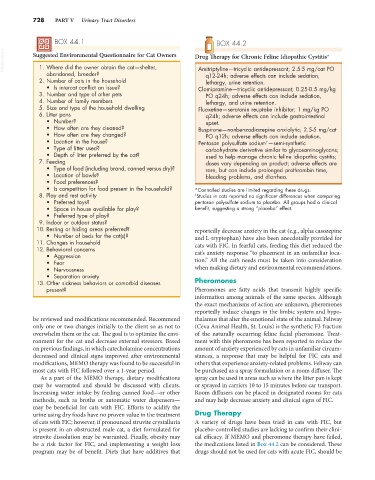Page 756 - Small Animal Internal Medicine, 6th Edition
P. 756
728 PART V Urinary Tract Disorders
BOX 44.1 BOX 44.2
VetBooks.ir Suggested Environmental Questionnaire for Cat Owners Drug Therapy for Chronic Feline Idiopathic Cystitis*
1. Where did the owner obtain the cat—shelter,
abandoned, breeder? Amitriptyline—tricyclic antidepressant; 2.5-5 mg/cat PO
q12-24h; adverse effects can include sedation,
2. Number of cats in the household lethargy, urine retention.
• Is intercat conflict an issue? Clomipramine—tricyclic antidepressant; 0.25-0.5 mg/kg
3. Number and type of other pets PO q24h; adverse effects can include sedation,
4. Number of family members lethargy, and urine retention.
5. Size and type of the household dwelling Fluoxetine—serotonin reuptake inhibitor; 1 mg/kg PO
6. Litter pans q24h; adverse effects can include gastrointestinal
• Number? upset.
• How often are they cleaned? Buspirone—nonbenzodiazepine anxiolytic; 2.5-5 mg/cat
• How often are they changed? PO q12h; adverse effects can include sedation.
• Location in the house? Pentosan polysulfate sodium —semi-synthetic
†
• Type of litter used? carbohydrate derivative similar to glycosaminoglycans;
• Depth of litter preferred by the cat? used to help manage chronic feline idiopathic cystitis;
7. Feeding doses vary depending on product; adverse effects are
• Type of food (including brand, canned versus dry)? rare, but can include prolonged prothrombin time,
• Location of bowls? bleeding problems, and diarrhea.
• Food preferences?
• Is competition for food present in the household? *Controlled studies are limited regarding these drugs.
8. Play and rest activity † Studies in cats reported no significant differences when comparing
• Preferred toys? pentosan polysulfate sodium to placebo. All groups had a clinical
• Space in house available for play? benefit, suggesting a strong “placebo” effect.
• Preferred type of play?
9. Indoor or outdoor status?
10. Resting or hiding areas preferred? reportedly decrease anxiety in the cat (e.g., alpha casozepine
• Number of beds for the cat(s)? and L-tryptophan) have also been anecdotally provided for
11. Changes in household cats with FIC. In fearful cats, feeding this diet reduced the
12. Behavioral concerns
• Aggression cat’s anxiety response “to placement in an unfamiliar loca-
• Fear tion.” All the cat’s needs must be taken into consideration
• Nervousness when making dietary and environmental recommendations.
• Separation anxiety
13. Other sickness behaviors or comorbid diseases Pheromones
present? Pheromones are fatty acids that transmit highly specific
information among animals of the same species. Although
the exact mechanisms of action are unknown, pheromones
reportedly induce changes in the limbic system and hypo-
be reviewed and modifications recommended. Recommend thalamus that alter the emotional state of the animal. Feliway
only one or two changes initially to the client so as not to (Ceva Animal Health, St. Louis) is the synthetic F3 fraction
overwhelm them or the cat. The goal is to optimize the envi- of the naturally occurring feline facial pheromone. Treat-
ronment for the cat and decrease external stressors. Based ment with this pheromone has been reported to reduce the
on previous findings, in which catecholamine concentrations amount of anxiety experienced by cats in unfamiliar circum-
decreased and clinical signs improved after environmental stances, a response that may be helpful for FIC cats and
modifications, MEMO therapy was found to be successful in others that experience anxiety-related problems. Feliway can
most cats with FIC followed over a 1-year period. be purchased as a spray formulation or a room diffuser. The
As a part of the MEMO therapy, dietary modifications spray can be used in areas such as where the litter pan is kept
may be warranted and should be discussed with clients. or sprayed in carriers 10 to 15 minutes before car transport.
Increasing water intake by feeding canned food—or other Room diffusers can be placed in designated rooms for cats
methods, such as broths or automatic water dispensers— and may help decrease anxiety and clinical signs of FIC.
may be beneficial for cats with FIC. Efforts to acidify the
urine using dry foods have no proven value in the treatment Drug Therapy
of cats with FIC; however, if pronounced struvite crystalluria A variety of drugs have been tried in cats with FIC, but
is present in an obstructed male cat, a diet formulated for placebo-controlled studies are lacking to confirm their clini-
struvite dissolution may be warranted. Finally, obesity may cal efficacy. If MEMO and pheromone therapy have failed,
be a risk factor for FIC, and implementing a weight loss the medications listed in Box 44.2 can be considered. These
program may be of benefit. Diets that have additives that drugs should not be used for cats with acute FIC, should be

